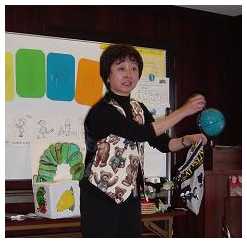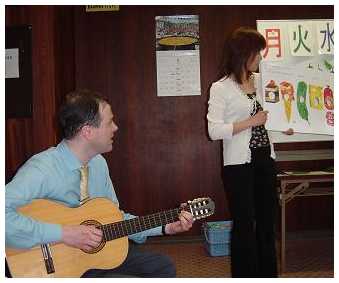
Sharing the Joy of Learning With Younger Students
Firsthand Report, Niigata JALT Chapter Meeting
Setsuko Toyama and Julian Whitney have been using picture books as a teaching resource for a number of years and have found them to be motivating and enjoyable. This
report, contributed by Julian Whitney, describes a workshop
they presented on May 12, 2002, at the International Friendship
Center in Niigata, Japan, for Niigata JALT. Participants were encouraged to
"come as children" in order to learn exciting lessons for
using picture books to teach younger learners of English.
Read with me and I will read: activities that work in primary schools
Uncharacteristically, the Ministry of Education, Sports, Science, and Technology have not prescribed content, so teachers find themselves presented with the happy situation of creating programmes most suited to local needs. But "Where to start?" and "What to teach?" is a pressing concern.
Setsuko Toyama and Julian Whitney showed thirty-one teachers from Niigata city how Picture Books provide a rich resource of learning opportunities.
Using the perennial favourite The Very Hungry Caterpillar, Setsuko and Julian described a three-stage process for exploiting Picture Books in the language classroom;
Report by Julian Whitney
2002 ESL MiniConference Online
 This year has seen the introduction of the Integrated-Studies programme into Japanese primary schools. Schools have been given free-rein to create their own curricula, drawing from Environmental Studies, Information Technology, and Foreign Languages, and many schools are electing to include English in the 105 hours available.
This year has seen the introduction of the Integrated-Studies programme into Japanese primary schools. Schools have been given free-rein to create their own curricula, drawing from Environmental Studies, Information Technology, and Foreign Languages, and many schools are electing to include English in the 105 hours available.
* Reading:
* Post-Reading: Two participants impressed us all by their rapid learning of Korean in the last game; Setsuko showed us how the dice-game could be used to teach the very useful "I'm hungry!," in any language. As children, we tried out Korean. As teachers, we learned that Picture Books provide a very rich and readily available resource of English language material for those involved in primary education in Japan.
Two participants impressed us all by their rapid learning of Korean in the last game; Setsuko showed us how the dice-game could be used to teach the very useful "I'm hungry!," in any language. As children, we tried out Korean. As teachers, we learned that Picture Books provide a very rich and readily available resource of English language material for those involved in primary education in Japan.
julianwhitney@hotmail.com
Niigata, Japan